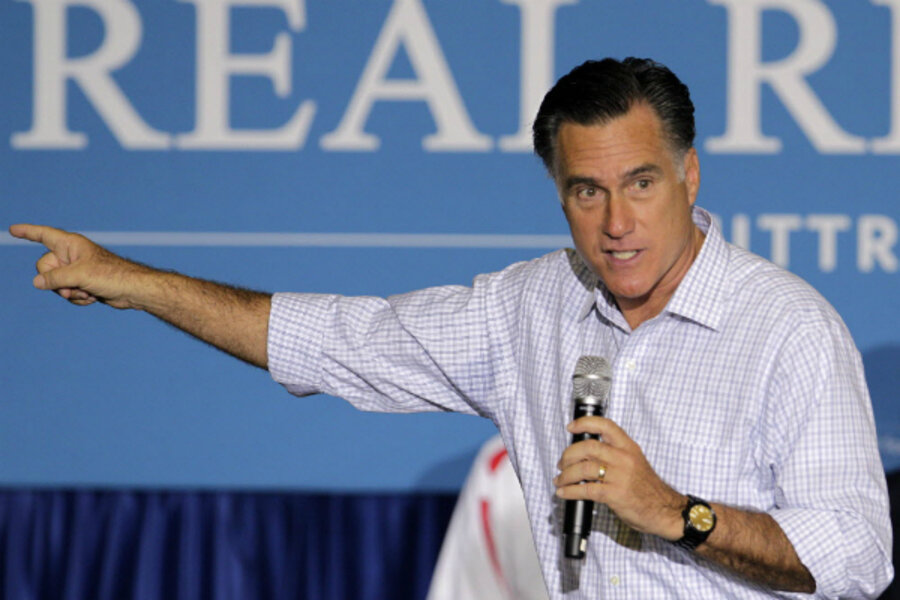Polls show Obama with big leads in Ohio, Florida. Could they be wrong?
Loading...
Polls out Wednesday show President Obama with big leads in the key states of Ohio, Florida, and Pennsylvania. That’s been kind of a recurring story in recent days, hasn’t it?
The Quinnipiac University/CBS News/New York Times surveys have Mr. Obama ahead of GOP nominee Mitt Romney by 53 to 43 percent in Ohio, 53 to 44 percent in Florida, and 54 to 42 percent in the Keystone State.
“Gov. Mitt Romney had a bad week in the media and it shows in these key swing states,” said Peter Brown, assistant director of the Quinnipiac University Polling Institute, in a statement. “The furor over his 47 percent remark almost certainly is a major factor in the roughly double-digit leads [of] President Barack Obama .... The debates may be Romney’s best chance to reverse the trend in his favor.”
Well, we’ve got a couple things to say about these surveys. The first is that they’re more pro-Obama than the RealClearPolitics rolling average for these states, at the moment. As of Wednesday, this broader measure has Obama up by 5.2 percentage points in Ohio, 49.3 to 44.1 percent; 3.1 points in Florida, 49.2 to 46.1 percent; and 8.3 points in Pennsylvania, 50 to 41.7 percent.
Our second comment is that it’s likely there is more than the “47 percent” stuff at work here. As we’ve written before, studies generally show that such individual moments move the polls little, if at all. It’s just as likely that there’s a larger attitudinal shift occurring into which the “47 percent” feeds.
That shift might be a generally more positive attitude toward the economy in these states, if not the nation as a whole. As Mr. Brown of Quinnipiac notes, their new surveys show respondents split down the middle as to whether they are better or worse off than four years ago.
“If voters don’t think they are worse off, it is difficult to see them throwing out an incumbent whose personal ratings with voters remains quite high,” said Brown.
Some political scientists who specialize in election forecasting have long said that America’s economic fundamentals are, on balance, just good enough to allow Obama to squeak to victory. True, unemployment remains very high, but mixed with such other measures as the change in GDP growth quarter-to-quarter, the index of leading economic indicators, and so forth, the overall result is of a slightly brightening horizon.
“Now, there is reason to believe that Obama is not going to get 52 percent or 54 percent of the two-party vote. But I think a broader review of the evidence suggests that the economy is, on balance, slightly favorable for him,” writes John Sides, George Washington University associate professor of political science, on the Monkey Cage political science blog.
Finally, there's this question: Is it possible the polls are all wrong? That’s been an increasingly popular theme among conservatives in recent days. Their basic complaint is that many recent polls oversampled Democrats – in other words, included more of them than will actually vote in November.
Conservative talk-show host Hugh Hewitt hits this point Wednesday on his blog. He says the Quinnipiac swing-state poll results show a Democratic turnout advantage of 9 percent in Ohio, 11 percent in Florida, and 12 percent in Pennsylvania.
“Utter nonsense in other words, designed by who knows who for the purpose of collecting a check and generating a headline,” he writes.
Pollsters reply that party ID as measured in polls is fungible, and depends in part on which candidate voters favor; that Democrats do outnumber Republicans in the United States; and that polls conservatives point to as more accurate, such as Rasmussen, don’t include cellphones and thus miss many minorities and young people.
“It’s not stretching. That’s statistics and mathematics. I’m not making this stuff up,” said Lee Miringoff, director of the Marist Institute for Public Opinion, in a discussion with Mr. Hewitt on this subject earlier this month.








